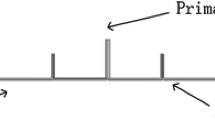Abstract
The structural design for worktable stiffeners plays an important role in determining dynamic characteristic of heavy-duty vertical lathe which directly affects the machining performance. In this paper, a stiffener design method for worktable stiffeners combining modal analysis and topology optimization is proposed to improve the static and dynamic performances. The dynamic characteristics of worktable are analyzed by modal analysis, and the weak part of the worktable base is determined by combining the results of modal analysis and vibration signal processing. An initial optimal structure of the worktable base is obtained by solid isotropic material with penalization (SIMP) based on topology optimization. Then, the layout of stiffeners is remodeled according to the initial optimal structure by number and size optimization. Finite element analyses are implemented to evaluate the performance of the newly designed structure. The natural frequency of the worktable base is increased by 7.59% with a decrease of 11% in the mass. Experiments are carried out to verify the validity of the proposed stiffener design method. The experimental result also shows that the natural frequencies of the worktable base have increased by more than 10%.















Similar content being viewed by others
References
Bui TQ, Nguyen DD, Zhang XD, Hirose S, Batra RC (2016) Analysis of 2-dimensional transient problems for linear elastic and piezoelectric structures using the consecutive-interpolation quadrilateral element (cq4). European J Mech 58:112–130
Bui TQ, Vo DQ, Zhang CZ, Nguyen DD (2014) A consecutive-interpolation quadrilateral element (cq4): formulation and applications. Finite Elem Anal Des 84(4):14–31
Changliang YU, Zhang H, Wang R, Guo L (2013) Study on method for weak link identification of dynamic stiffness of a machine tool and optimization design. J Mech Eng 49(21):11
El-Sabbagh A, Akl W, Baz A (2008) Topology optimization of periodic mindlin plates. Finite Elem Anal Des 44(8):439–449
Karunaratne M, Sagahyroon A (2015) A dynamic power estimation method for system on chip designs. J Low Power Electron 11(4):455–466
Kroll L, Blau P, Wabner M, Frieß U, Eulitz J, klärner M (2011) Lightweight components for energy-efficient machine tools. Cirp J Manuf Sci Technol 4(2):148–160
Li B, Hong J, Wang Z, Wu W, Chen Y (2012) Optimal design of machine tool bed by load bearing topology identification with weight distribution criterion. Procedia Cirp 3(1):626–631
Li B, Luo B, Mao XY, Cai H, Peng FY, Liu HQ (2013) A new approach to identifying the dynamic behavior of cnc machine tools with respect to different worktable feed speeds. Int J Mach Tools Manuf 72(3):73–84
Liu C, Tan F, Wang L, Cai Z (2016) Research on optimization of column structure design for dynamic performance of machine tool. J Mech Eng 52(3):161
Liu H, Zhang W, Gao T (2015) A comparative study of dynamic analysis methods for structural topology optimization under harmonic force excitations. Struct Multidiscip Optim 51(6):1321–1333
Liu SH (2015) Multi-objective optimization design method for the machine tool’s structural parts based on computer-aided engineering. Int J Adv Manuf Technol 78(5-8):1–13
Nguyen MN, Bui TQ, Truong TT, Tanaka S, Hirose S (2017) Numerical analysis of 3-d solids and composite structures by an enhanced 8-node hexahedral element. Finite Elem Anal Des 131(C):1–16
Nguyen MN, Bui TQ, Truong TT, Trinh NA, Singh IV, Yu TT, Doan DH (2016) Enhanced nodal gradient 3d consecutive-interpolation tetrahedral element (cth4) for heat transfer analysis. Int J Heat Mass Transf 103:14–27
Sun SH, Yu TT, Nguyen TT, Atroshchenko E, Bui TQ (2018) Structural shape optimization by igabem and particle swarm optimization algorithm. Eng Anal Bound Elem 88:26–40
Wang C, Yu TT, Shao GJ, Nguyen TT, Bui TQ (2019) Shape optimization of structures with cutouts by an efficient approach based on XIGA and chaotic particle swarm optimization. European J Mech A Solid 74:176–187
Xia Q, Shi TL, Wang MY (2011) A level set based shape and topology optimization method for maximizing the simple or repeated first eigenvalue of structure vibration. Struct Multidiscip Optim 43(4):473–485
Zargham S, Ward TA, Ramli R, Badruddin IA (2016) Topology optimization: a review for structural designs under vibration problems. Struct Multidiscip Optim 53(6):1157–1177
Zhang H, Ding XH, Dong XH, Xiong M (2018) Optimal topology design of internal stiffeners for machine pedestal structures using biological branching phenomena. Struct Multidiscip Optim 57(6):2323–2338
Zhao L, Ma J, Wang T, Xing D (2010) Lightweight design of mechanical structures based on structural bionic methodology. J Biomech Eng 7(4):S224–S231
Acknowledgements
The authors would like to thank the anonymous reviewers for their careful, constructive and insightful comments to improve the quality of the present contribution.
Funding
This work is supported by the National Natural Science Foundation of China (51805116).
Author information
Authors and Affiliations
Corresponding authors
Additional information
Responsible Editor: Mehmet Polat Saka
Ethical statement
The manuscript entitled “A stiffener structural design method for worktable of heavy-duty vertical lathe by combining modal analysis and topology optimization” has not been previously published, which is not currently submitted for review to any other journal, and will not be submitted elsewhere before a decision is made by this journal. The authors declare that they have no conflict of interest.
Publisher’s note
Springer Nature remains neutral with regard to jurisdictional claims in published maps and institutional affiliations.
Rights and permissions
About this article
Cite this article
Jin, H., Yang, F., Wang, H. et al. A stiffener structural design method for worktable of heavy-duty vertical lathe by combining modal analysis and topology optimization. Struct Multidisc Optim 60, 745–756 (2019). https://doi.org/10.1007/s00158-019-02235-5
Received:
Revised:
Accepted:
Published:
Issue Date:
DOI: https://doi.org/10.1007/s00158-019-02235-5




